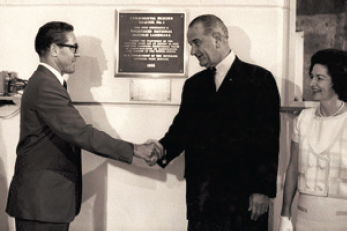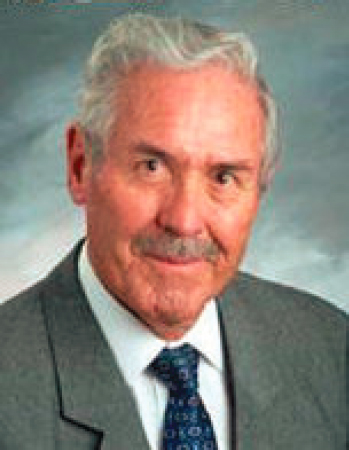

LEONARD J. KOCH
1920–2015
Elected in 1981
“Contributions to fast reactor development, applying nuclear power to electricity generation and articulating the facts about nuclear power.”
BY JOHN A. SHANAHAN
SUBMITTED BY THE NAE HOME SECRETARY
LEONARD JOHN KOCH, an internationally recognized pioneer in the development of breeder reactor nuclear power technology, died May 15, 2015, at the age of 95 as a result of complications from a fall.
His father, Philip, was a machinist and his mother, Christine, a homemaker. Len was born March 30, 1920, at home on the south side of Chicago, two months premature; his mother and aunt kept him alive. In fact, the primary emphasis of his early childhood was on survival since the family was dirt poor, especially during the 1930s.
He became particularly aware of financial circumstances during his senior year at Morgan Park High School. His fellow students planned to go to college, and he pretended to be going also. He received a “half scholarship” to attend an “accounting college,” then heard about the co-op program at Armour Institute of Technology, now Illinois Institute of Technology; the 5-year program in mechanical engineering involved 8-week semesters of school and work for 5 years. He worked at Liquid Carbonic Corp., manufacturer of bottle-filling machines.
Upon graduation in 1943, he worked for three companies in the development and manufacture of internal combustion engines, his love at the time. The first company was Chrysler
Corporation, where he worked during World War II on development of engines for state-of-the-art bombers for service in the Pacific. Then at Tucker Corporation he worked on rear-mounted engines for high-performance automobiles. It was there that he learned about Argonne National Laboratory and atomic energy.
Len applied to ANL and was interviewed by the director, Walter Zinn.1 He was incredibly lucky to be in the right place at the right time: He was hired in 1948 for the Experimental Breeder Reactor-I project, thanks to his experience in solving practical engineering problems for important government and private industry projects, and Zinn became his mentor and hero. EBR-I was the first reactor to produce electricity that lit the entire facility.
Len next became project manager of EBR-II, responsible for its development, design, and construction. It was the first US attempt to develop a small prototype of the long-range concept of future nuclear plants, which had been conceived by Enrico Fermi and his colleagues and scientifically demonstrated by the EBR-I experiment. When the EBR-II facility commenced operation, the project organization was dissolved.
Len became director of ANL’s Reactor Engineering Division in 1963, responsible for engineering development and “the next step” in the advancement of nuclear power. Unfortunately—for Len and for nuclear power in the United States—the Atomic Energy Commission revised its nuclear development organizational structure in 1972. This was a time when the nation was faced with the monumental task of reconciling energy needs, environmental concerns, and economic goals. Len concluded that the government was not likely to design or build any more experimental power reactors and left Argonne in 1972.
From the federal sector he went to work as vice president at Illinois Power Co. (IP), which was starting plans for a standard commercial light water reactor (LWR) nuclear power plant—the company’s first involvement in nuclear power plants. But
___________________
1 See his tribute on pp. 397–403 in this volume.
the project received a significant blow from the Three Mile Island accident in early 1979, at about the peak construction period of the IP Clinton Power Station. Len persisted, and continued to stump for “real nuclear power” breeder reactors, but when it became obvious that he would not be able to finish the plant before his retirement, he retired in 1983. From then until his passing in 2015, Len was active with many other pioneering scientists and engineers in promoting public education about nuclear power.
Notwithstanding the disappointments, his contributions were recognized with his election to the NAE in 1981. In 2004 he was awarded the Global Energy International Prize from Russia “for his pioneering contribution to the development of fast-breeder nuclear reactors for power generation and fundamental studies into the thermophysical properties of matter at extremely high temperatures.” It was the technical recognition highlight of his life. In 2007 he received the Walter H. Zinn Medal from the Operations and Power Division of the American Nuclear Society, an award that had special significance for him because of his long and special association with Zinn. In 2012 the American Nuclear Society awarded Len the W. Bennett Lewis Award for lifetime contributions to nuclear science and sustainable energy.
The standard LWR commercial plant used in all countries has become the workhorse for generating electricity using nucear power. While these plants have been very successful and well managed, they have a once-through fuel design that uses only about 1 percent of the potential nuclear energy in the original ore. The uranium-fueled breeder reactor technology that Len helped pioneer with spent-fuel recycling can use nearly all the potential energy stored in the ore.
If the LWR spent fuel and depleted uranium from the enrichment process stored in the United States were used in breeder reactors, it would have a value of several trillion dollars and be able to power all the electrical energy needs of the United States for several thousand years. University of Pittsburgh physics professor Bernard Cohen published an estimate in 1983 that breeder reactors like the one Len helped
develop could use the available uranium ore from mining on the land and dissolved uranium in the oceans to provide all the energy the world will need for electricity and other energy applications for as long as humans will live on Earth.2 Nuclear-powered fast reactors have an added advantage of being able to use thorium, which is more abundant than uranium, making the technology potentially even more sustainable.
In the twilight of his life Len participated in the effort to educate the public with facts about energy options. He gave talks in towns where he lived and engaged in internet discussions with nuclear advocates. He also published “Fast Reactor Future – The Vision of an Atomic Energy Pioneer”3 (online at thesciencecouncil.com) and “Nuclear power – The next 50 years and beyond” (in Nuclear News in 2002). He worked with John Shanahan, founder of the website allaboutenergy.net, where he and Ted Rockwell provided advice and articles for public education.
And on a beautiful day in April 2013, Len stepped lively up to a video camera situated among flowering cactus and other desert plants in Tucson, Arizona, the Tucson Mountains in the background. With a friendly smile and firm voice, he described how nuclear power had been his life’s work, avocation, and obsession. He said he hoped that America would embrace nuclear energy and not let false alarmists and politicians force the country to think it can rely on wind and solar.
Len’s wife, Rosemarie (née Schafer), predeceased him in 2007. They are survived by son William Koch and two grandchildren.
___________________
2 Cohen BL. 1983. Before It’s Too Late: A Scientists’s Case for Nuclear Energy. New York: Plenum Press.
3 Based on his presentation at the international symposium “Science and Society,” March 13, 2005, in St. Petersburg, Russia.






